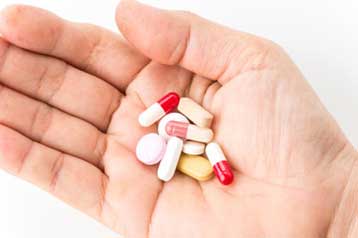Escherichia coli
- What is Escherichia coli?
- What are Shiga toxin-producing E. coli?
- Are there important differences between E. coli O157 and other STEC?
- Who gets STEC infections?
- What are the symptoms of STEC infections?
- What are the complications of STEC infections?
- How soon do symptoms appear after exposure?
- Where do STEC come from?
- How are these infections spread?
- Where did my infection come from?
- How common are STEC infections?
- How are STEC infections diagnosed?
- How long can an infected person carry STEC?
- What is the best treatment for STEC infection?
- Should an infected person be excluded from school or work?
- How can STEC infections be prevented?
Escherichia coli (abbreviated as E. coli) are a large and diverse group of bacteria. Although most strains of E. coli are harmless, others can make you sick. Some kinds of E. coli can cause diarrhea, while others cause urinary tract infections, respiratory illness and pneumonia, and other illnesses. Still other kinds of E. coli are used as markers for water contamination—so you might hear about E. coli being found in drinking water, which are not themselves harmful, but indicate the water is contaminated. It does get a bit confusing—even to microbiologists.
What are Shiga toxin-producing E. coli?
Some kinds of E. coli cause disease by making a toxin called Shiga toxin. The bacteria that make these toxins are called “Shiga toxin-producing” E. coli, or STEC for short. You might hear them called verocytotoxic E. coli (VTEC) or enterohemorrhagic E. coli (EHEC); these all refer generally to the same group of bacteria. The most commonly identified STEC in North America is E. coli O157:H7 (often shortened to E. coli O157 or even just “O157”). When you hear news reports about outbreaks of “E. coli” infections, they are usually talking about E. coli O157.
In addition to E. coli O157, many other kinds (called serogroups) of STEC cause disease. These other kinds are sometimes called “non-O157 STEC.” E. coli serogroups O26, O111, and O103 are the non-O157 serogroups that most often cause illness in people in the United States.
Are there important differences between E. coli O157 and other STEC?
Most of what we know about STEC comes from outbreak investigations and studies of E. coli O157 infection, which was first identified as a pathogen in 1982. The non-O157 STEC are not nearly as well understood, partly because outbreaks due to them are rarely identified. As a whole, the non-O157 serogroup is less likely to cause severe illness than E. coli O157; however, some non-O157 STEC serogroups can cause the most severe manifestations of STEC illness.
People of any age can become infected. Very young children and the elderly are more likely to develop severe illness and hemolytic uremic syndrome (HUS) than others, but even healthy older children and young adults can become seriously ill.
What are the symptoms of STEC infections?
The symptoms of STEC infections vary for each person but often include severe stomach cramps, diarrhea (often bloody), and vomiting. If there is fever, it usually is not very high (less than 101˚F/less than 38.5˚C). Most people get better within 5–7 days. Some infections are very mild, but others are severe or even life-threatening.
What are the complications of STEC infections?
Around 5–10% of those who are diagnosed with STEC infection develop a potentially life-threatening complication known as hemolytic uremic syndrome (HUS). Clues that a person is developing HUS include decreased frequency of urination, feeling very tired, and losing pink color in cheeks and inside the lower eyelids. Persons with HUS should be hospitalized because their kidneys may stop working and they may develop other serious problems. Most persons with HUS recover within a few weeks, but some suffer permanent damage or die.
How soon do symptoms appear after exposure?
The time between ingesting the STEC bacteria and feeling sick is called the “incubation period.” The incubation period is usually 3-4 days after the exposure, but may be as short as 1 day or as long as 10 days. The symptoms often begin slowly with mild belly pain or non-bloody diarrhea that worsens over several days. HUS, if it occurs, develops an average 7 days after the first symptoms, when the diarrhea is improving.
STEC live in the guts of ruminant animals, including cattle, goats, sheep, deer, and elk. The major source for human illnesses is cattle. STEC that cause human illness generally do not make animals sick. Other kinds of animals, including pigs and birds, sometimes pick up STEC from the environment and may spread it.
How are these infections spread?
Infections start when you swallow STEC—in other words, when you get tiny (usually invisible) amounts of human or animal feces in your mouth. Unfortunately, this happens more often than we would like to think about. Exposures that result in illness include consumption of contaminated food, consumption of unpasteurized (raw) milk, consumption of water that has not been disinfected, contact with cattle, or contact with the feces of infected people. Some foods are considered to carry such a high risk of infection with E. coli O157 or another germ that health officials recommend that people avoid them completely. These foods include unpasteurized (raw) milk, unpasteurized apple cider, and soft cheeses made from raw milk. Sometimes the contact is pretty obvious (working with cows at a dairy or changing diapers, for example), but sometimes it is not (like eating an undercooked hamburger or a contaminated piece of lettuce). People have gotten infected by swallowing lake water while swimming, touching the environment in petting zoos and other animal exhibits, and by eating food prepared by people who did not wash their hands well after using the toilet. Almost everyone has some risk of infection.
Where did my infection come from?
Because there are so many possible sources, for most people we can only guess. If your infection happens to be part of the about 20% of cases that are part of a recognized outbreak, the health department might identify the source.
How common are STEC infections?
Experts think that there may be about 70,000 infections with E. coli O157 each year in the United States. We can only estimate because we know that many infected people do not seek medical care,many do not submit a stool specimen for testing, and many labs do not test for STEC. We think that a similar number of persons have diarrhea caused by non-O157 STEC. Many labs do not identify non-O157 STEC infection because it takes even more work than identifying E. coli O157.
How are STEC infections diagnosed?
STEC infections are usually diagnosed through lab testing of stool specimens (feces). Identifying the specific strain of STEC involved is very important for public health purposes, such as finding outbreaks. Most labs can determine if an STEC is present and can identify E. coli O157. To determine the O group of non-O157 STEC, strains must be sent to a State Public Health laboratory.
How long can an infected person carry STEC?
STEC typically disappear from the feces by the time the illiness is resolved, but may be shed for several weeks, even after symptoms go away. Young children tend to carry STEC longer than adults. A few people keep shedding these bacteria for several months. Good hand-washing is always a smart idea to protect yourself, your family, and other persons.
What is the best treatment for STEC infection?
Non-specific supportive therapy, including hydration, is important. Antibiotics should not be used to treat this infection. There is no evidence that treatment with antibiotics is helpful, and taking antibiotics may increase the risk of HUS. Antidiarrheal agents like Imodium® may also increase that risk.
Should an infected person be excluded from school or work?
School and work exclusion policies differ by local jurisdiction. Check with your local or state health department to learn more about the laws where you live. In any case, good hand-washing after changing diapers, after using the toilet, and before preparing food is essential to prevent the spread of these and many other infections.
How can STEC infections be prevented?
- WASH YOUR HANDS thoroughly after using the bathroom or changing diapers and before preparing or eating food. WASH YOUR HANDS after contact with animals or their environments (at farms, petting zoos, fairs, even your own backyard)
- COOK meats thoroughly. Ground beef and meat that has been needle-tenderized should be cooked to a temperature of at least 160°F/70˚C. It’s best to use a thermometer, as color is not a very reliable indicator of “doneness.”
- AVOID raw milk, unpasteurized dairy products, and unpasteurized juices (like fresh apple cider).
- AVOID swallowing water when swimming or playing in lakes, ponds, streams, swimming pools, and backyard “kiddie” pools.
PREVENT cross contamination in food preparation areas by thoroughly washing hands, counters, cutting boards, and utensils after they touch raw meat.
Department of Health and Human Services
centers for Disease Control and Prevention
http://www.cdc.gov/






